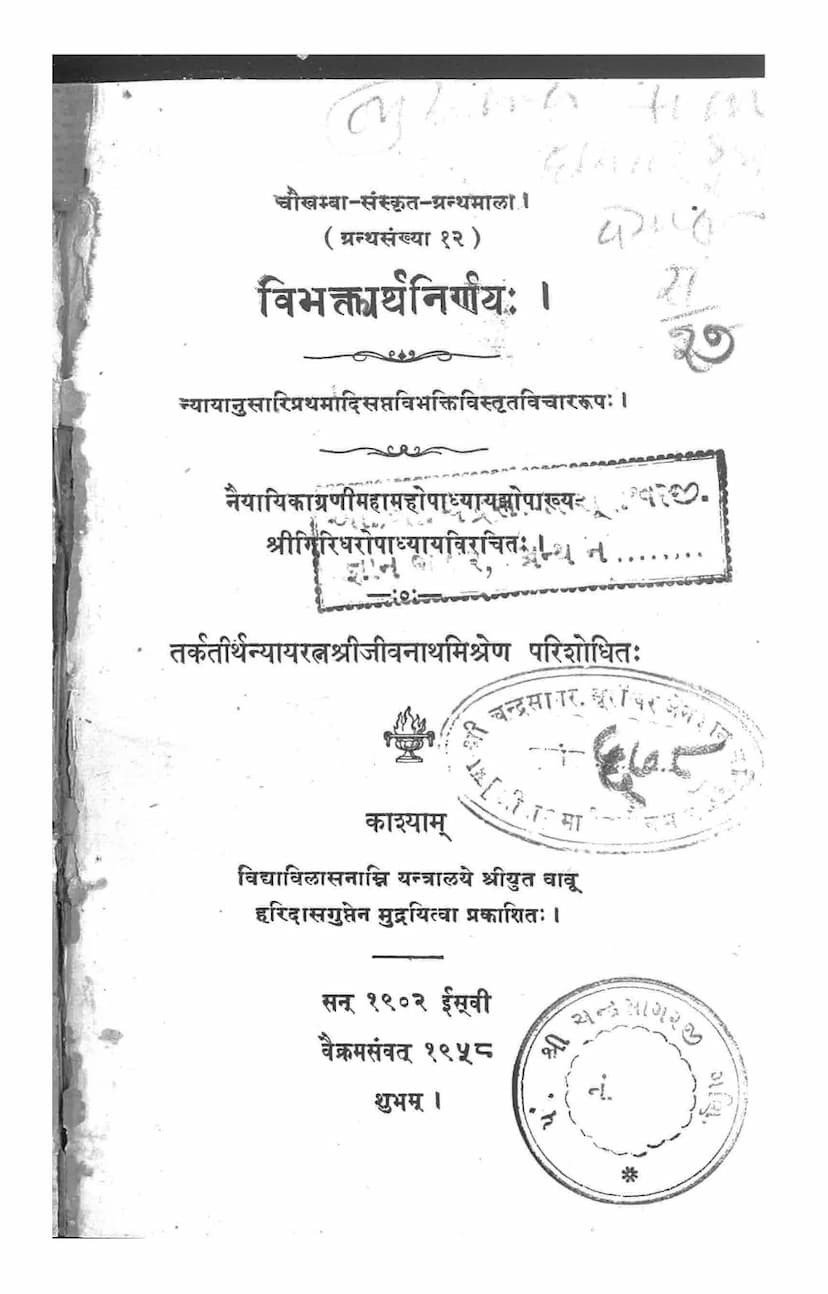Vibhaktarthanirnaya
Added to library: September 2, 2025

Summary
Here's a comprehensive summary of the Jain text "Vibhaktarthanirnaya" based on the provided pages:
Book Title: Vibhaktarthanirnaya (The Determination of the Meaning of Inflections) Author(s): Giridhar Upadhyay, Jivnath Mishra Publisher: Babu Haridas Gupta Publication Date: 1902 AD (Vikram Samvat 1958) Catalog Link: https://jainqq.org/explore/009651/1
Overall Purpose: "Vibhaktarthanirnaya" is a detailed treatise on the meanings of the seven Sanskrit grammatical case inflections (vibhakti) as understood within the Nyaya school of Indian philosophy. It aims to clarify and determine the precise significance of each case ending, often by analyzing grammatical rules and providing extensive commentary. The book thoroughly examines the concept of "karaka" (grammatical agent or function) and its relation to the various case endings.
Key Aspects and Content:
-
Author and Context:
- The text is authored by Giridhar Upadhyay, a scholar from Mithila, belonging to the Jhau lineage. He was the son of Vagish Sharma and was educated by Gokulnath Upadhyay, a renowned scholar of the 16th century Shaka era.
- The work was revised and published by Tarkatirtha Nyayaratna Jivnath Mishra.
- The publisher, Babu Haridas Gupta, brought out the book in 1902 AD from the Vidyavilas Press in Kashi.
- The preface indicates that this work is a revival of an ancient text, presented with modern relevance and detailed discussion.
-
Subject Matter - The Seven Cases (Vibhakti):
- The central theme is the exhaustive analysis of the meanings (artha) associated with the seven grammatical case inflections in Sanskrit:
- Prathama (Nominative)
- Dvitiya (Accusative)
- Tritiya (Instrumental)
- Chaturthi (Dative)
- Panchami (Ablative)
- Shashthi (Genitive)
- Saptami (Locative)
- The book elaborates on the detailed meaning and application of each case, often by explaining the sutras (aphorisms) of Panini.
- The central theme is the exhaustive analysis of the meanings (artha) associated with the seven grammatical case inflections in Sanskrit:
-
Focus on Nyaya Philosophy:
- The author's approach is consistently aligned with the principles and interpretations of the Nyaya school of philosophy. This means discussions will involve concepts like pramana (means of knowledge), pratiti (cognition), anvaya (connection), pratiyogita (counter-position), samavaya (inherence), and other epistemological and metaphysical concepts central to Nyaya.
-
Detailed Analysis of "Karaka":
- A significant portion of the book is dedicated to defining and understanding "karaka" (grammatical function or case relation). The author engages with various philosophical viewpoints (like those of the Naiyayikas and Shabdas) to determine the essence of karakatva.
- The text explores the relationship between case endings and karakas, discussing whether karakatva is a universal concept or derived from individual case meanings.
- The author critically examines different definitions of karaka, such as action-relatedness (kriyanvayitva), distinguishing it from mere relation (sheshatva).
-
Explanations of Panini's Sutras:
- The commentary follows and explains the grammatical rules laid down by the great grammarian Panini, particularly those related to the case inflections and their application. The text often refers to "Padavakyaratnakara" and other grammatical works for comparative analysis.
-
Methodology:
- Elaboration and Commentary: The book provides extensive commentary on the meanings of each case, often dissecting specific words and their grammatical functions.
- Refutation of Other Views: The authors engage in critical analysis, refuting alternative interpretations (especially from the Shabda school of grammar) and justifying the Nyaya perspective with logical arguments.
- Examples: Numerous examples from classical Sanskrit literature and everyday usage are used to illustrate the application of rules and the meanings of inflections.
-
Structure:
- The "Vibhaktayarthanirnaya" appears to follow a systematic approach, likely dedicating chapters or sections to each case from Prathama to Saptami.
- The index (Vishay Soochi) on pages 13-19 reveals a very detailed structure, covering topics like:
- The duality of case meanings (Vibhaktiyarthadvaividhyam).
- The concept of "karaka" (Karakatvanugama), including arguments for and against its unity.
- The definition of "vibhakti" itself.
- Detailed discussions for each case, referencing specific Panini sutras (e.g., "Karturipsitaretam karma" for Dvitiya, "Kartrukararayoh" for Tritiya, "Sampradane Chaturthi," "Dhruvamapaye Panchami," "Shashthi Shesha," "Saptamyadhikarane cha").
- Discussions on akarak (non-karaka) uses of cases.
- Philosophical debates on the nature of address (sambodhana) for the Prathama case.
- Analysis of compound words and their grammatical implications.
-
Significance:
- The book is a valuable resource for understanding Sanskrit grammar from a Nyaya philosophical perspective.
- It highlights the intricate relationship between language, logic, and philosophy in classical Indian traditions.
- The detailed and analytical approach makes it a scholarly work contributing to the study of semantics and grammar.
In essence, "Vibhaktarthanirnaya" is a rigorous, philosophically grounded exploration of Sanskrit case grammar, authored by eminent scholars, that delves into the profound meanings and logical underpinnings of each inflection within the Nyaya tradition.